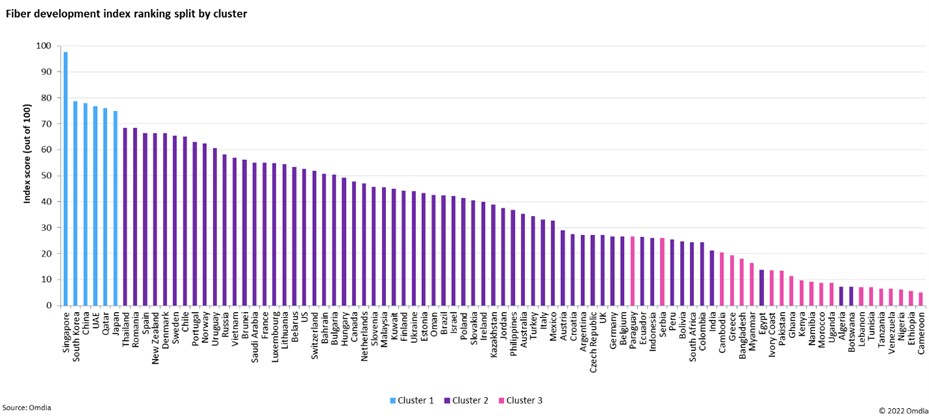Singapore holds lead position in Omdia Fibre Development Index
Singapore has again emerged as leader in Omdia’s Global Fibre Development 2022 Index, with maximum scores in seven of the nine metrics (referenced below).
It is closely followed by South Korea, China, the UAE, Qatar, and Japan. All territories in the leading cluster benefit from strong national broadband plans with ambitious targets around ultra-high-speed services.
The UK is 53rd on this list, highlighting the need for more ambitious fibre deployment strategies from the government and internet service providers in the region. The UK Government’s manifesto commitment was to deliver nationwide gigabit-broadband (FTTP) by 2025, which was revised in November 2020 to a minimum of 85% of premises by 2025. In February 2022, the UK set a new target for nationwide gigabit-broadband to be available by 2030. In comparison, Singapore is already claiming full FTTP coverage, where it is treated as ‘strategic infrastructure’.
Historically, several otherwise highly developed broadband territories that rank lower in the fibre index tended to suffer from less clear or ambitious national plans, providing weaker incentives for operators to invest. However, due in part to the COVID-19 crisis demonstrating how important broadband networks are, governments are now strengthening their broadband targets and increasing their focus and investments in fibre-based infrastructure.
The findings from this report will be discussed at the upcoming Network X event in Amsterdam, 18-20 October 2022. Network X Research Director, Michael Philpott said: “Fibre investment is an essential metric for government institutions and other stakeholders to track. As a broadband-access technology, optical fibre provides an optimised, highly sustainable, and future-proof quality service. This superior level of quality is essential for the development of future digital services and applications across all verticals.
“With increased efficiency stimulating greater innovation, high-speed broadband has been proven to drive not just consumer satisfaction but national economic indicators such as GDP and productivity. Only by maximising investment in next-generation access can countries optimise their growth potential, and fibre-optic technology is key to that investment. Countries, such as the UK and the US, that are further down the list than many less developed countries, may need to consider policy reforms to ensure that it is easy to deploy infrastructure and that competition in the market remains high in light of mergers taking place,” Philpott finished.

Index tracks and benchmarks fibre again a broad set of fibre investment metrics across 88 countries, including:
- Fibre to the premises coverage
- Fibre to the household penetration
- Fibre to the business penetration
- Mobile cell site fibre penetration
- Advanced WDM technology investment
Based on Omdia’s analysis of Ookla Speedtest data, the Index also quantifies the overall broadband quality of experience improvements driven by that investment, namely:
- Median download speed
- Median upload speed
- Median latency
- Median jitter
Michael Philpott and a team of Omdia analysts will be presenting and debating a wide range of upcoming telecoms issues and trends at Network X between 18-20 October 2022.


